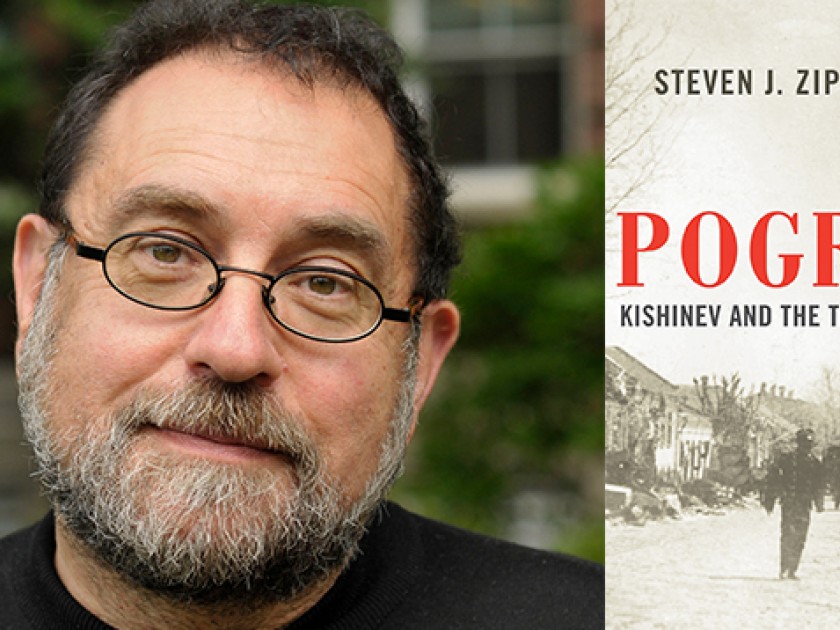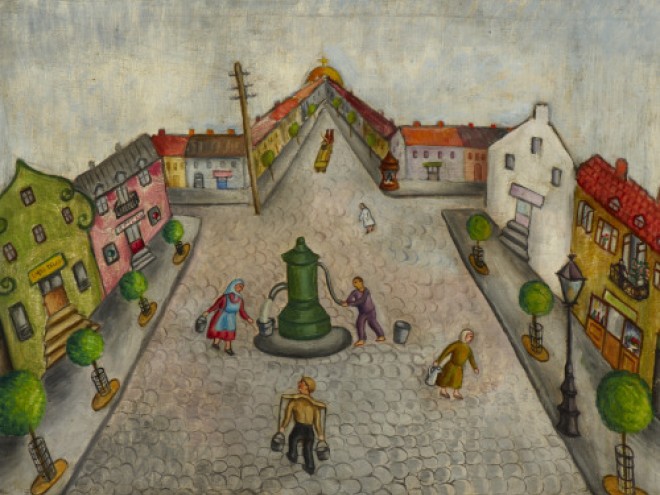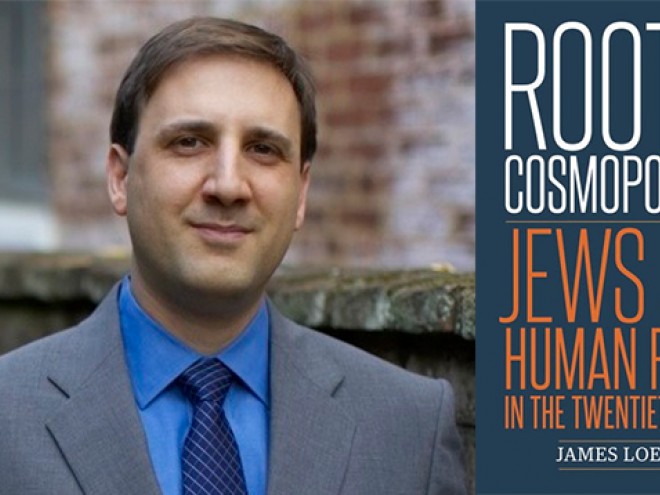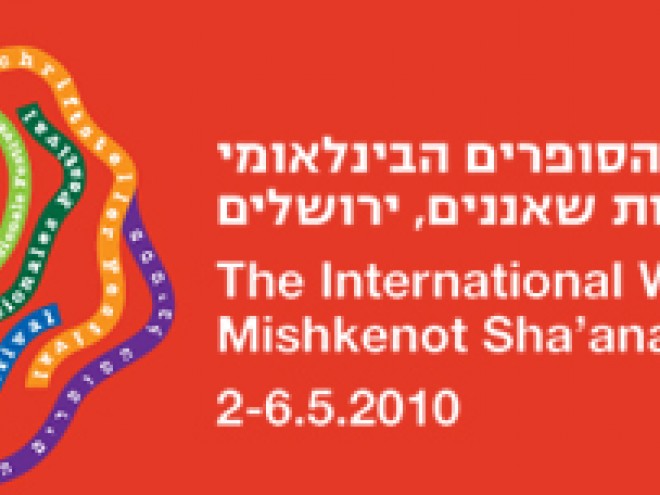
Author photo: Tony Rinaldo
Professor Steven Zipperstein’s new book, Pogrom, is about the massacre of Jews in Kishinev in 1903. Bob Goldfarb spoke with him recently about his findings.
Bob Goldfarb: In Pogrom, you document how Pavel Krushevan, an anti-Semitic newspaper publisher in Kishinev, fabricated the “Protocols of the Elders of Zion” — and you uncovered some facts about his life that were previously unknown. It’s quite a breakthrough. What led you there?
Steven Zipperstein: It was really accidental. Many authors of the first books about the “Protocols” had no idea that the Kishinev version had even been published. Later an Italian scholar demonstrated that the word endings in the book version of the “Protocols”indicate quite clearly that it had originated in or around Bessarabia. I was able to connect that version to the pogrom. A superb German scholar, Michael Hagemeister, mentioned to me that a Moldovan Jewish journalist in Brookline, Massachusetts had something, and I was in Boston on my way to Moldova the next day. I called this man and asked him if I could come by. I’m sitting in his living room, and from a shelf in his living room, he takes a large white folder, massively packed with documents, and I begin to leaf through it. What I discovered are treasures.
BG: What was in the folder, and where did he get it?
SZ: The archive came to the journalist because he was writing a history of an insane asylum at the edge of Chisinau (Kishinev), and he had befriended a nephew of Krushevan’s. The nephew admired his uncle, and Krushevan gave the nephew his most sensitive papers, documenting financial misdeeds, shenanigans, bankruptcies. Still more surprising was his diary, written at the age of 15 or 16. He’s staying with relatives in Odessa, and he’s having joyous sex with a Cossack — they come in only one gender. And he declares that he wishes he had been born “a lady.”
BG: Did the documents shed any light on the man he became?
SZ: Krushevan is one of the great totems of anti-capitalist, homophobic, anti-Semitic attitudes. I also discovered that Krushevan’s life was spent in close proximity to Jews. His stepsister had run off with a Jew, moved to Baltimore, and is pictured in a Russian-language newspaper as an Orthodox Jew living a Jewish life with her husband. What’s more, from the age of two, Krushevan was raised by a stepmother who was Jewish.
BG: You write that there was not a lot of overt anti-Semitism in Kishinev before the pogrom, that the populations lived relatively amicably together. It calls to mind more recent cases of pogroms, or genocides, where the same was true. In Jedwabne, Poland, Jews and Poles knew one another intimately, yet the Poles savagely murdered their Jewish neighbors. In Rwanda, Hutus and Tutsis lived side by side, intermarried, and then the Hutus perpetrated genocide against the Tutsis on an incomprehensible scale. Shouldn’t familiarity bring sympathy and understanding?
SZ: In the Kishinev pogrom we have a good many instances of Jews under attack who run into the courtyard of Gentile friends, expecting their protection and not infrequently being protected. But there is a relationship between familiarity and outright ferocity, as Jan Gross argues in his book Neighbors: The Destruction of the Jewish Community in Jedwabne, Poland. That serves as a cautionary note with regard to the notion that knowing someone better — as liberalism would like to believe — moderates negative feelings.
In Kishinev, one woman was raped by a man whom she had suckled when he was an infant. A shoemaker was attacked by a man one week after the shoemaker repaired his shoes. Another sobering example is that of Minister of the Interior Vyacheslav Konstantinovich Plehve, whose hatred for Jews seems to have deepened as a young boy growing up in Warsaw in a neighborhood close to Jews. He attributes some of his animosity toward Jews to that proximity.
BG: Is there any lesson to be drawn from this?
SZ: For me, the most sobering lesson to be drawn is about what we now call “fake news.” So much of what resonated about the pogrom were myths, fictions. Myth and fiction have a kind of coherence history doesn’t have. History is full of loose seams and odd edges. With Kishinev, here’s an event that’s probably the best documented in all of Russian Jewish history, and at the same time the most mythologized. The massive amount of documentation does relatively little to unsettle the myths over the course of the last century.
BG: The Hearst newspapers played a large role in publicizing the Kishinev massacre in the United States. The Hearst newspapers also whipped up fervor in favor of a war with Spain in 1898 by fabricating atrocities. The Kishinev pogrom did happen; the Spanish atrocities did not. If a story has the same power whether it’s true or not, it gives one pause, doesn’t it?
SZ: I would go even further. The made-up stories have greater power than the actual stories. They’re fuller, more zaftig, than the news can possibly be. The so-called Plehve letter surfaced a few weeks after the pogrom, and it seemed to furnish empirical proof that the Russian government was behind the pogroms. The letter was a forgery. Yet, it had considerable impact on facilitating mass migration by Russian Jews to the U.S.
BG: Speaking of myths, you conclusively demonstrate that the “Protocols” is a fraud. It’s another great example of the persistence of myth in the face of fact.
SZ: It’s striking that the “Protocols” is really the only anti-Semitic text — among so many anti-Semitic texts that have been published — that continues to have a real life. It actually provides a voice, albeit a false voice, of the “Elder.” One reason for its success is its redundancy. You don’t need to read more than a page to get what it’s about. Somehow this text, which is profoundly localized, ends up speaking to so many different audiences in so many countries.
BG: One of the myths that helped inform the pogrom in Kishinev is that Jews drained the blood of Christian children. It seems to be another example of people believing what they want to believe, so it becomes a kind of “truth,” like the other myths we’ve been talking about.
SZ: You’re right. Disproving something that doesn’t exist is extraordinarily tough. Every time there was a ritual-murder accusation, the coroners set about testing whether the body was drained of blood. The act of disproving the murder serves to validate the notion that ritual murder exists! How do you disprove an absurdity?
BG: You talk about how Kishinev has vastly disproportionate prominence in people’s memory. Many, many more people were killed in pogroms in subsequent years. Yet, despite the hundreds of thousands of casualties in later years, Kishinev stands out. Why?
SZ: This is the first pogrom in a new century. And it’s institutionalized: in Zionist memory, in Socialist memory. It’s adopted by the now-powerful Yiddish-speaking Left in New York. It’s introduced not only into politics but also into plays, synagogue ritual, and arguably the best poem in a Jewish language in modernity, Bialik’s “City of Killing.” It inspired the very play that introduced the notion of the “melting pot.”
There’s also an interplay with the relatively small number of Jews who were killed, all of whom can be pictured in a single photograph, shrouded before their burials. It’s impossible to photograph 600 dead, let alone 200,000 dead. We’ve discovered over time that unthinkable catastrophes are best concretized in small numbers.
BG: You point out that the impact of Kishinev went well beyond the Jewish community. News of Kishinev affected Booker T. Washington, and at least indirectly led to the founding of the NAACP. It’s hard to imagine how a distant atrocity could have such impact.
SZ: In some ways it’s precisely because it’s hard to imagine it that it had the impact that it did. It dominated the headlines for weeks, and was denounced by Theodore Roosevelt. It changed the way lynching is discussed in the U.S. The outrage over Kishinev, in contrast to the lack of outrage over lynchings in the U.S., was itself felt to be outrageous and sparked a corrective on American soil.
BG: Reading history, one can’t help but look for some sort of redemptive lesson: if pogroms could bring about a movement for social change, perhaps that’s a kind of comfort. Yet the pogroms were also followed by the rapid growth of the Ku Klux Klan in the U.S., and the massacre of Armenians in 1915, so the anti-lynching movement is only part of a larger picture.
SZ: One of the most extraordinary aspects of history is its formlessness, and the way people try to create a coherence out of this formlessness; that’s what I study. I leave moral lessons to others. What came to intrigue me at the outset is how this particular episode stuck so resolutely, while others — arguably more important — have disappeared. If I’ve explicated that, I’ve done what I set out to do.
Bob Goldfarb is President Emeritus of Jewish Creativity International.



